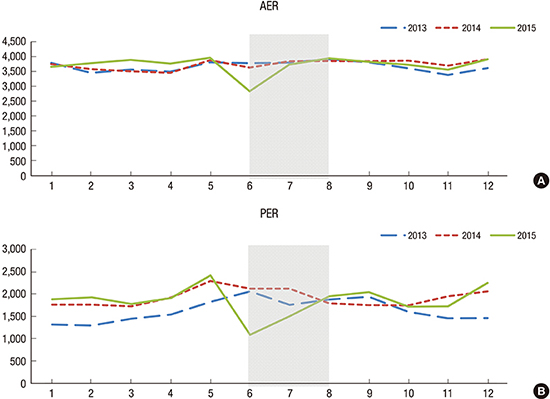1. Oh MD, Choe PG, Oh HS, Park WB, Lee SM, Park J, Lee SK, Song JS, Kim NJ. Middle East Respiratory Syndrome Coronavirus superspreading event involving 81 persons, Korea 2015. J Korean Med Sci. 2015; 30:1701–1705.
2. Ki M. 2015 MERS outbreak in Korea: hospital-to-hospital transmission. Epidemiol Health. 2015; 37:e2015033.
3. Huang CC, Yen DH, Huang HH, Kao WF, Wang LM, Huang CI, Lee CH. Impact of Severe Acute Respiratory Syndrome (SARS) outbreaks on the use of emergency department medical resources. J Chin Med Assoc. 2005; 68:254–259.
4. Choi JY. An outbreak of Middle East Respiratory Syndrome Coronavirus infection in South Korea, 2015. Yonsei Med J. 2015; 56:1174–1176.
5. Miroballi Y, Baird JS, Zackai S, Cannon JM, Messina M, Ravindranath T, Green R, Della-Latta P, Jenkins S, Greenwald BM, et al. Novel influenza A (H1N1) in a pediatric health care facility in New York City during the first wave of the 2009 pandemic. Arch Pediatr Adolesc Med. 2010; 164:24–30.
6. Kwan-Gett TS, Baer A, Duchin JS. Spring 2009 H1N1 influenza outbreak in King County, Washington. Disaster Med Public Health Prep. 2009; 3:Suppl 2. S109–S116.
7. Sills MR, Hall M, Simon HK, Fieldston ES, Walter N, Levin JE, Brogan TV, Hain PD, Goodman DM, Fritch-Levens DD, et al. Resource burden at children's hospitals experiencing surge volumes during the spring 2009 H1N1 influenza pandemic. Acad Emerg Med. 2011; 18:158–166.
8. Sugerman D, Nadeau KH, Lafond K, Cameron W, Soetebier K, Jhung M, Isakov A, Greenwald I, Neil K, Schrag S, et al. A survey of emergency department 2009 pandemic influenza A (H1N1) surge preparedness--Atlanta, Georgia, July-October 2009. Clin Infect Dis. 2011; 52:Suppl 1. S177–S182.
9. McDonnell WM, Nelson DS, Schunk JE. Should we fear “flu fear” itself? Effects of H1N1 influenza fear on ED use. Am J Emerg Med. 2012; 30:275–282.
10. Heiber M, Lou WY. Effect of the SARS outbreak on visits to a community hospital emergency department. CJEM. 2006; 8:323–328.
11. Kang CK, Song KH, Choe PG, Park WB, Bang JH, Kim ES, Park SW, Kim HB, Kim NJ, Cho SI, et al. Clinical and epidemiologic characteristics of spreaders of Middle East Respiratory Syndrome Coronavirus during the 2015 outbreak in Korea. J Korean Med Sci. 2017; 32:744–749.
12. Wuerz RC, Milne LW, Eitel DR, Travers D, Gilboy N. Reliability and validity of a new five-level triage instrument. Acad Emerg Med. 2000; 7:236–242.
13. Pines JM, Hilton JA, Weber EJ, Alkemade AJ, Al Shabanah H, Anderson PD, Bernhard M, Bertini A, Gries A, Ferrandiz S, et al. International perspectives on emergency department crowding. Acad Emerg Med. 2011; 18:1358–1370.
14. Shin TG, Song JW, Song HG, Hong CK. Characteristics of frequent users of emergency department. J Korean Soc Emerg Med. 2011; 22:86–92.
15. Lee HJ, Park SY, Lee YH, Do BS, Lee SB. Clinical analysis of the pediatric patients seen in the emergency medical center. Korean J Pediatr. 2005; 48:1061–1067.
16. Yoo JW, Lee JH. Clinical analysis of pediatric patients who visited a general hospital emergency center. Korean J Pediatr. 2010; 53:314–322.
17. Cha WC, Shin SD, Song KJ, Jung SK, Suh GJ. Effect of an independent-capacity protocol on overcrowding in an urban emergency department. Acad Emerg Med. 2009; 16:1277–1283.
18. Jang DH, Kwak YH, Kim DK, Jung JY, Suh DB, Chang I, Jung JH, Seo HH, Kim JW, Choo JH. Unplanned revisit to pediatric emergency department: patients’ characteristics and relationship with overcrowding. J Korean Emerg Med. 2014; 25:529–535.
19. Ro YS, Shin SD, Song KJ, Cha WC, Cho JS. Triage-based resource allocation and clinical treatment protocol on outcome and length of stay in the emergency department. Emerg Med Australas. 2015; 27:328–335.
20. Carret ML, Fassa AG, Kawachi I. Demand for emergency health service: factors associated with inappropriate use. BMC Health Serv Res. 2007; 7:131.
21. Rubinson L, Mutter R, Viboud C, Hupert N, Uyeki T, Creanga A, Finelli L, Iwashyna TJ, Carr B, Merchant R, et al. Impact of the fall 2009 influenza A (H1N1) pdm09 pandemic on US hospitals. Med Care. 2013; 51:259–265.
22. Nelson DS, Walsh K, Fleisher GR. Spectrum and frequency of pediatric illness presenting to a general community hospital emergency department. Pediatrics. 1992; 90:5–10.
23. Duclos P, Sanderson LM, Lipsett M. The 1987 forest fire disaster in California: assessment of emergency room visits. Arch Environ Health. 1990; 45:53–58.
24. Rhim JW, Lee KY, Youn YS, Kang JH, Kim JC. Epidemiological and clinical characteristics of childhood pandemic 2009 H1N1 virus infection: an observational cohort study. BMC Infect Dis. 2011; 11:225.
25. Nam SS, Do BS, Park SY, Lee SB. Comparison of the clinical characteristics of the patients visited in emergency department with pandemic 2009 influenza A (H1N1) virus infection during the first three years; an observational study at a single emergency department. J Korean Soc Emerg Med. 2014; 25:84–89.
26. Choi JS, Kim KM. Crisis prevention and management by infection control nurses during the Middle East Respiratory Coronavirus outbreak in Korea. Am J Infect Control. 2016; 44:480–481.
27. Lee J. Better understanding on MERS Corona Virus outbreak in Korea. J Korean Med Sci. 2015; 30:835–836.







 PDF
PDF ePub
ePub Citation
Citation Print
Print





 XML Download
XML Download